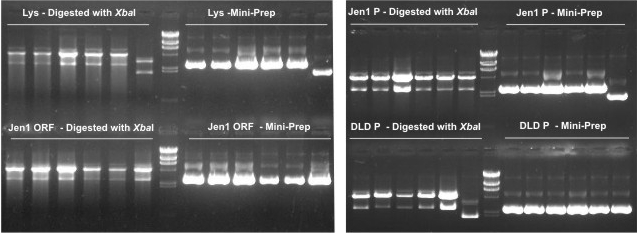Team:UNICAMP-Brazil/Notebooks/September 13
From 2009.igem.org
(→New biobrick - The first screening) |
|||
| Line 7: | Line 7: | ||
====finO+pSB1A3==== | ====finO+pSB1A3==== | ||
| - | * After the O/N period, today we transformed the ligation finO+pSB1A3 into electrocompetent E. coli bacteria, strain DH10B. We followed | + | *<p style=”text-align:justify;”>After the O/N period, today we transformed the ligation finO+pSB1A3 into electrocompetent ''E. coli'' bacteria, strain DH10B. We followed [https://2009.igem.org/Team:UNICAMP-Brazil/Protocols/Electroporation Protocol 3] |
| - | * We then plated the transfomed cells in LB-AMP | + | , without modifications.</p> |
| + | *<p style=”text-align:justify;”>We then plated the transfomed cells in LB-AMP medium, and let them grow at 37ºC for an O/N period.</p> | ||
====finP+pSB1A3==== | ====finP+pSB1A3==== | ||
| - | * We followed the same produce for the finP+pSB1A3 ligation. | + | *<p style=”text-align:justify;”>We followed the same produce for the finP+pSB1A3 ligation.</p> |
''Marcelo'' | ''Marcelo'' | ||
| Line 20: | Line 21: | ||
====New biobrick - The first screening==== | ====New biobrick - The first screening==== | ||
| - | * 6 colonies of each new biobrick were chosen of the plates made yesterday to grow in liquid LB. | + | *<p style=”text-align:justify;”>6 colonies of each new biobrick were chosen of the plates made yesterday to grow in liquid LB.</p> |
| - | * Then, we performed miniprep to get our new biobricks purified ([https://2009.igem.org/Team:UNICAMP-Brazil/Protocols/Mini-Prep Protocol 2]). | + | *<p style=”text-align:justify;”>Then, we performed miniprep to get our new biobricks purified ([https://2009.igem.org/Team:UNICAMP-Brazil/Protocols/Mini-Prep Protocol 2]).</p> |
| - | * We then digested the plasmids obtained by the miniprep with ''Xba''I to confirm the correct ligation of the parts following the biobrick format ([https://2009.igem.org/Team:UNICAMP-Brazil/Protocols/T4_DNA_Ligase Protocol 11]). However, the electrophoresis gel (shown below) showed an unexpected pattern of bands that can't confirm correctly ligations of our biobricks. =( | + | *<p style=”text-align:justify;”>We then digested the plasmids obtained by the miniprep with ''Xba''I to confirm the correct ligation of the parts following the biobrick format ([https://2009.igem.org/Team:UNICAMP-Brazil/Protocols/T4_DNA_Ligase Protocol 11]). However, the electrophoresis gel (shown below) showed an unexpected pattern of bands that can't confirm correctly ligations of our biobricks. =(</p> |
[[Image:MInipreps e digestões Wesley.jpg |center|]] | [[Image:MInipreps e digestões Wesley.jpg |center|]] | ||
Revision as of 22:02, 3 October 2009
| ||||||||||||||||||||||||||||||||||
 "
"















